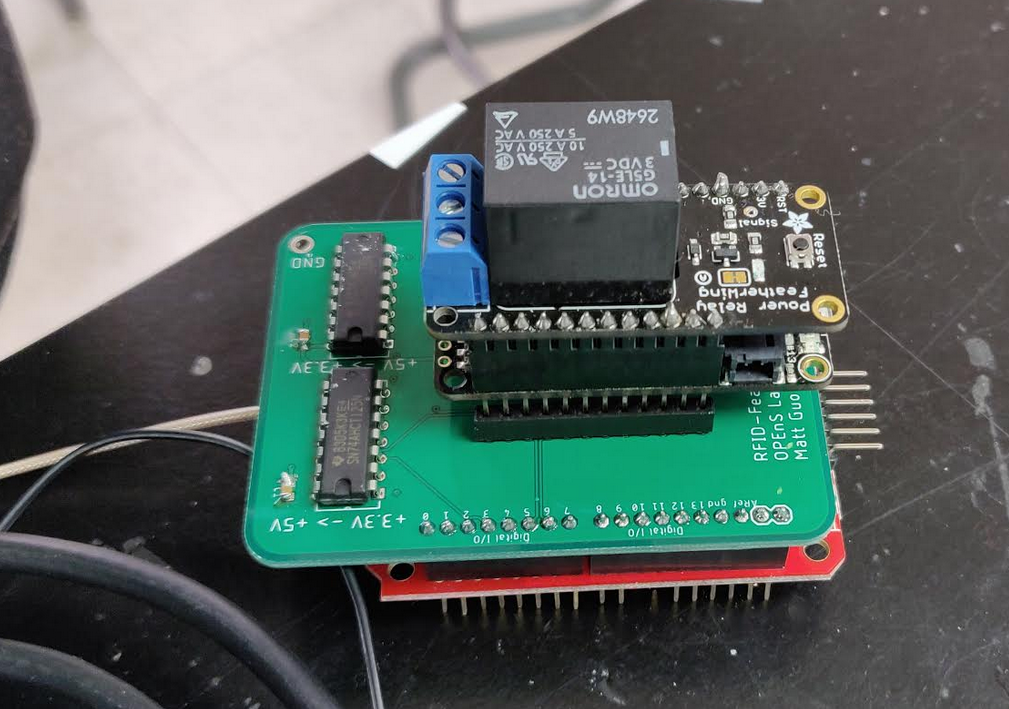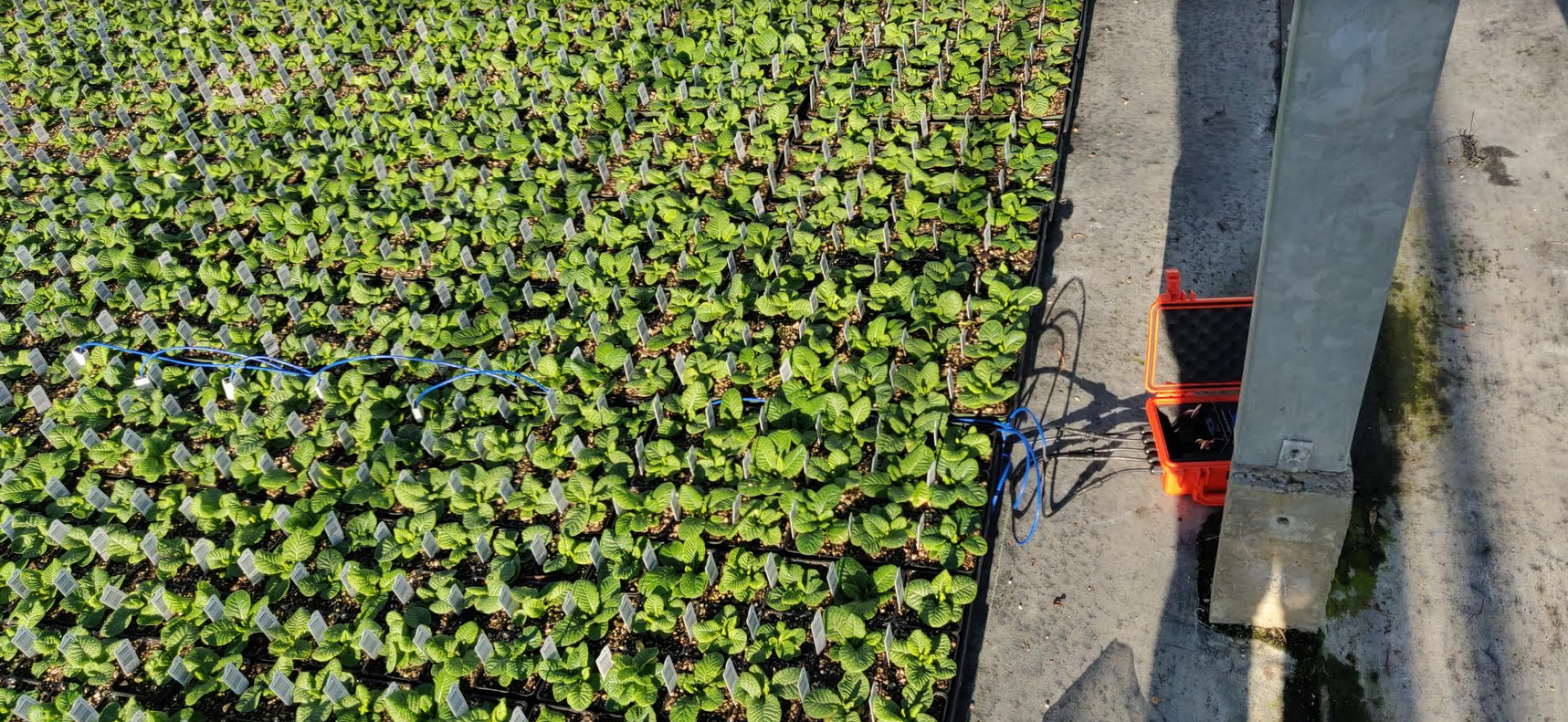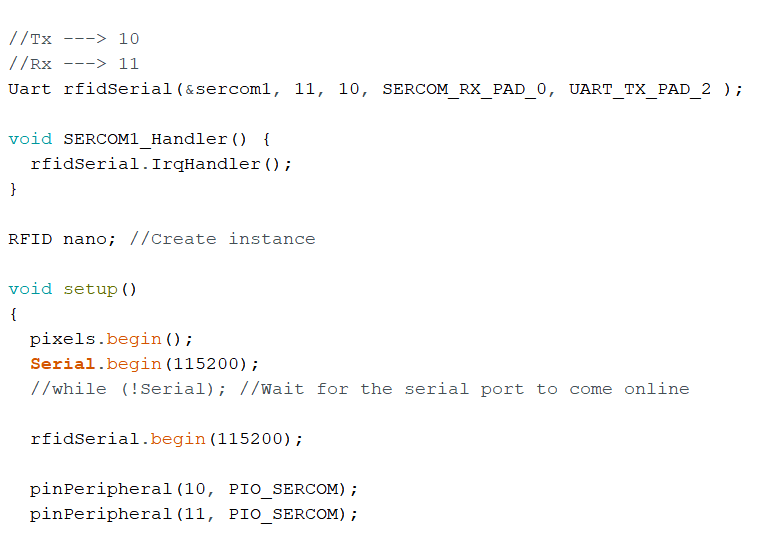-
Notifications
You must be signed in to change notification settings - Fork 3
RFID Moisture Updates
post newest updates at the top and have dividing lines between them:
Author: Matt Guo
- Created a working unified PCB for the RFID Module and Feather M0
Show More
DescriptionA unified PCB that interfaces the RFID Module to the Feather M0 has been designed, soldered, and tested. This PCB contains necessary routing from the TX and RX lines (Pins 11 and 10 on the Feather M0) to the soft-serial port on the SparkFun Simultaneous RFID Reader (Pins 2 and 3 on the RFID Module). Two SN74AHCT125N Logic Level shifters are used on this board, one that level shifts from 3.3V to 5V for the RFID Module, and the other from 5V to 3.3V for the Feather M0. Below is a figure of the board file for the interface PCB.

The top layer of the board lies the 5V plane from the USB pin of the Feather M0. This is what is used to power the 5V level shifter and the RFID Module. The bottom of the board contains the common ground plane. The "Analog In" ports of the RFID Module hookup, which is based off of the same topology as an Arduino UNO, is connected to GPIO A0 - A5 of the Feather M0, should additional GPIO be needed for this design.
The interface board sandwiches the Feather M0 and the RFID Module, with the RFID Module on the bottom and the Feather M0 on the top for ease of access. This is best illustrated in the pictures below.


The red bottom board is the RFID Module, and two board on top of the interface board is the Feather M0 and the Adafruit Relay Switch used to control the irrigation system.
This board was also tested using the Arduino IDE and the revised Feather M0 skeleton code detailed in the previous update log. The 3.3V TX line from the Feather M0 is logic level shifted up to 5V for the RX line of the RFID Module, and the 5V TX of the RFID Module is then logic level shifted down to 3.3V for the Feather M0. The figure below illustrates proper initialization communication between the two.

Author: Matt Guo & Max Chu
- Adafruit Soil Moisture Sensors deployed at Peoria Gardens
Show More
DescriptionThe Soil Moisture Dataloggers passed the OPEnS lab QA test, deeming it worthy to be deployed at Peoria Gardens. Three Dataloggers were deployed, with 5 Adafruit Capacitive Soil Moisture Sensors attached to each of the Dataloggers, bringing a total of 15 different sensors testing the moisture level of different soils. Each of the Dataloggers uses one Feather M0 with a multiplexer running on Loom and an OPEnS Hypnos Board to log the moisture value and the timestamp of the measurement. A 6 cell battery is used to power these Dataloggers, capable of a runtime of 10 days per single charge.
Below is the setup of a Datalogger:

The PORT number, start time, plant, and box numbers are listed below.
BOX 1 - Measuring Japanese Holly (start time: 2:14pm 11/21/2019)
- Furthest Sensor: PORT7
- 2nd Furthest Sensor: PORT5
- 3rd Furthest Sensor: PORT4
- 4th Furthest Sensor: PORT2
- Closest Sensor: PORT0

BOX2 - Measuring Pansy Fizzle Sizzle Mix (start time: 2:04pm 11/21/2019)
- Furthest Sensor: PORT0
- 2nd Furthest Sensor: PORT1
- 3rd Furthest Sensor: PORT4
- 4th Furthest Sensor: PORT6
- Closest Sensor: PORT7

BOX3 - Measuring Primula (start time: 2:24pm 11/21/2019)
- Furthest Sensor: PORT0
- 2nd Furthest Sensor: PORT1
- 3rd Furthest Sensor: PORT4
- 4th Furthest Sensor: PORT6
- Closest Sensor: PORT7

Author: Matt Guo
- Successful port of Sparkfun RFID constant read to Feather M0
Show More
Description
A successful port of the Sparkfun RFID constant read Arduino code to the Feather M0 has been made. To make this port successful, SN74AHCT125N logic level shifters were needed. These logic level shifters were used over the sparkfun breakout for their faster slew rates, required for high baud rate for the UART transmission. The SN74AHCT125N is a one-way logic level shifter - it can only go from 3.3V to 5V, or vice versa. The output logic level is dictated by the Vcc voltage. Two of these shifters were used for the design, one to transition from 3.3V to 5V, and the other going from 5V to 3.3V.
Below is the current setup for the RFID Soil Moisture Sensor Hardware:

The original Sparkfun RFID constant read code for the Arduino Uno utilizes the softSerial library for Tx and Rx pins on GPIO 2 and 3. When porting over to the Feather M0, this softSerial library is not available, thus alternatives were needed. Adapted from Adafruit's website on 'Adapting Uno Sketches to the M0', PIO_SERCOM's pinPeripheral was initialized on the code to the Feather M0's pins 10 and 11 for Tx and Rx. This allows the creation of a new serial, arbitrarily called as rfidSerial, to be used whenever UART communication is needed in the sketch.

Error's occurred whenever the rfidSerial was closed and reinitialized to actively change the baud rate, which was initially handled in the setupNano() function from the Constant Read code. This was avoided by initializing the rfidSerial to a set baud rate of 115200 and leaving the communication handling to 115200.

References:
- Project Planning
- Prototyping
- Synthesis
- Lab Testing
- Field Testing
- Finalization/Production
- Poster/Presentation
- Publication
- CRES
- Dendrometer
- Djinn
- eDNA Sampler
- eGreenhouse
- Evaporometer
- FloDar
- HyperRail
- Hypnos
- Isotopic Sampler
- Lilypad
- Loom
- Micro-Aggregating Sewer Sampler
- Mooraca
- OPEnSampler
- Pied Piper
- Rag Guard
- Rain Gauge Calibrator
- RainSavor
- RFID Moisture
- Sap Flow Meter
- SitkaNet
- Slide Sentinel
- Smart Rock
- Spool
- WeatherChimes
- Weed Warden
- Wisp
- Archived Project Blogs